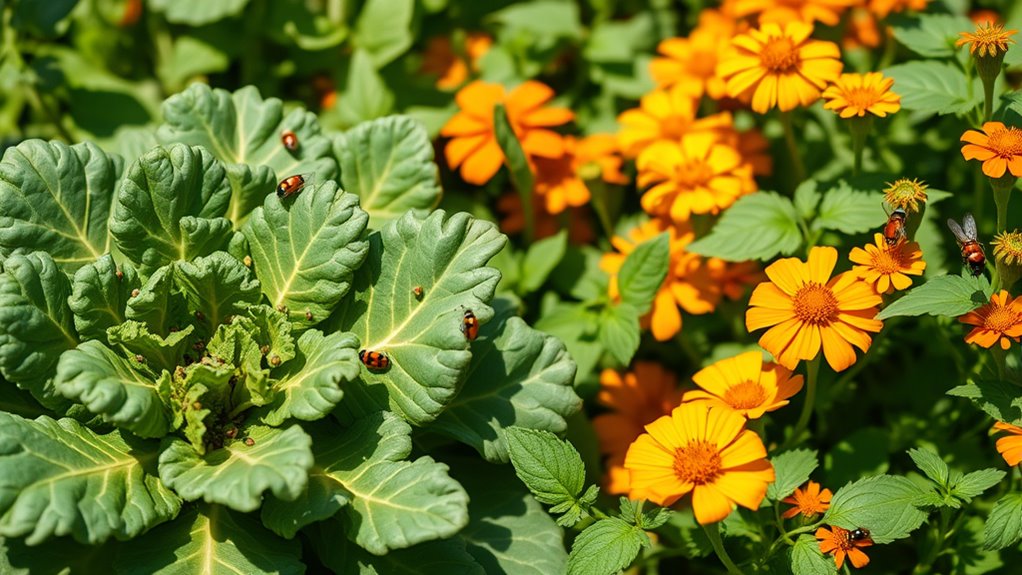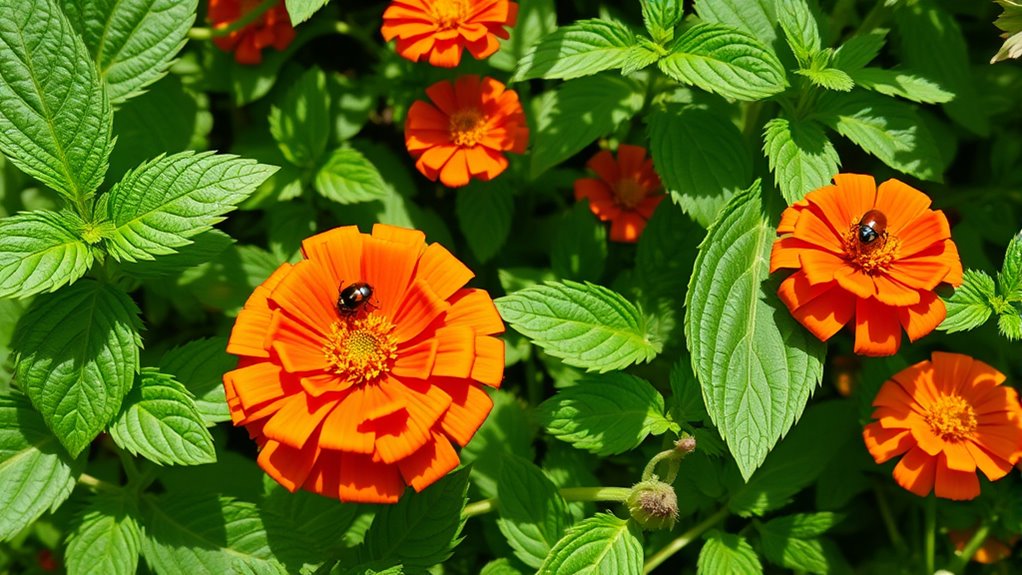To protect your garden naturally, incorporate companion plants that attract beneficial insects like ladybugs, lacewings, and parasitic wasps. Marigolds, dill, fennel, and tansy are great choices for drawing in helpful bugs that prey on common pests such as aphids and beetles. Strategic placement near vulnerable crops enhances pest control throughout the season. Exploring more about effective plant combinations can help you create a balanced, eco-friendly pest patrol system for your garden.
Key Takeaways
- Use plants like marigolds, dill, fennel, and tansy to attract beneficial insects that prey on common pests.
- Position companion plants near vulnerable crops to enhance pest control and prevent infestations.
- Rotate crops such as tomatoes with beans or carrots to disrupt pest life cycles naturally.
- Incorporate companion planting into your garden layout to reduce reliance on chemical pesticides.
- Combine crop rotation with beneficial insect attractants for an effective, eco-friendly pest management strategy.

Many gardeners turn to companion planting as a natural way to manage pests and protect their crops. By choosing the right plants to grow alongside your vegetables and herbs, you can encourage beneficial insects and reduce pest populations without relying on chemical pesticides. One key to successful companion planting is understanding how to attract beneficial insect attractants—plants that draw in helpful bugs like ladybugs, lacewings, and parasitic wasps. These insects prey on common pests such as aphids, caterpillars, and beetles, helping keep your garden balanced and healthy. Marigolds, dill, fennel, and tansy are excellent examples of beneficial insect attractants, as they produce scents or nectar that draw in these helpful insects. When you plant these alongside your main crops, you create a natural pest control system that operates continuously throughout the growing season. Recognizing how to promote active listening and empathy among beneficial insects can further enhance your garden’s pest management strategies.
Another important aspect of pest management through companion planting is implementing crop rotation strategies. By rotating your crops from year to year, you prevent pest populations that target specific plants from becoming established and thriving in your garden. For example, if you plant tomatoes one year, follow them with beans or carrots the next to break the pest cycle. This strategy not only disrupts pest life cycles but also improves soil health and reduces disease buildup. Combining crop rotation with the strategic placement of companion plants enhances your garden’s resilience. It minimizes the chances of pests overwintering in the soil and attacking your crops anew each season.
To maximize these benefits, plan your garden layout thoughtfully. Place beneficial insect attractants near crops that are particularly vulnerable to pests. For instance, plant dill or fennel near cucumbers or peppers, which attract aphids and other pests. This setup draws beneficial insects directly to the pests’ favorite targets, helping you control infestations before they spread. At the same time, practicing crop rotation ensures that pests don’t find a steady food source year after year, making your garden less inviting to pests overall. Combining these strategies creates a cycle of natural pest control that reduces the need for chemical interventions, making your garden safer and healthier for both you and the environment.
Frequently Asked Questions
Which Companion Plants Are Best for Organic Vegetable Gardens?
You should choose companion plants that attract beneficial insects and enhance your organic vegetable garden. Marigolds, nasturtiums, and bee balm create beneficial insect habitats, helping control pests naturally. Be sure to follow companion planting schedules to maximize benefits and avoid plant conflicts. Incorporating these plants not only improves pest management but also boosts overall garden health, making your organic veggies thrive without chemicals.
How Do I Attract Beneficial Insects With Companion Planting?
Ever wonder how to draw beneficial insects to your garden naturally? You can attract them by planting trap crops that lure pests away and providing habitat diversification with a variety of flowering plants. These methods create a welcoming environment, encouraging beneficial insects like ladybugs and hoverflies to settle in and help control pests. Isn’t it satisfying to nurture a balanced ecosystem that protects your vegetables without chemicals?
Are There Plants That Repel Pests Without Harming Pollinators?
You’re asking if there are plants that repel pests without harming pollinators. Many natural pest repellents, like marigolds and basil, effectively deter pests while still attracting beneficial insects. By planting these, you support beneficial insect attraction and protect pollinators. These plants create a balanced ecosystem, reducing pests naturally without risking pollinator health. It’s a smart, eco-friendly way to maintain a healthy garden while supporting beneficial insect activity.
How Often Should I Plant Companion Plants for Pest Control?
Oh, the thrill of endless planting schedules! You should plant companion plants regularly, ideally every few weeks, to maintain effective pest control. Incorporate diverse companion plantings to keep pests guessing and promote healthy growth. This way, you create a dynamic, resilient garden that naturally wards off pests without constant effort. Remember, the key is consistent diversity—your garden’s version of a lively, pest-free party!
Can Companion Planting Replace Chemical Pest Deterrents Entirely?
You might wonder if companion planting can replace chemical pest deterrents entirely. While it creates natural pest barriers and reduces the need for chemicals, relying solely on companion planting isn’t foolproof due to some common companion planting myths. It’s best to combine it with other integrated pest management strategies for effective pest control. This way, you support a healthier garden and minimize chemical use without risking pest outbreaks.
Conclusion
So, next time you plant those pesky pests’ favorite snacks, remember—they might just turn into your garden’s best allies. Ironically, by choosing the right companions, you can turn your garden into a pest’s worst nightmare without any harmful chemicals. Who knew that a little strategic pairing could save you from endless spraying? It’s almost like nature’s own pest control plan, proving that sometimes, the best defense is a clever plant or two.









